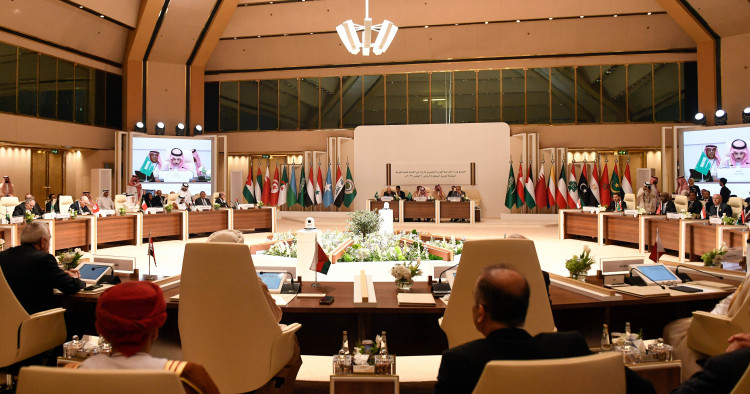Contents:
- America faces a brewing crisis of confidence among key Middle East partners
- With Gaza in crisis, the call for a ceasefire has never been more urgent
- Can Israel achieve its war objectives?
- Summit in Riyadh avoids adding unmanageably heavy pressure on Washington
- US struggles to re-establish deterrence amid ongoing attacks in Syria and Iraq
America faces a brewing crisis of confidence among key Middle East partners
Brian Katulis
Vice President of Policy

-
America and some of its close Arab partners are divided over the issue of a possible ceasefire in the Gaza war.
-
This difference of views could negatively impact the working relationships between the United States and key Middle East countries able to play an important role in containing the spread of conflict and planning for the post-war future.
Five weeks into the Israel-Hamas war, the United States faces a brewing crisis of confidence among some of its closest partners in the Middle East. Since the early stages of this conflict, the United States has seen a divergence between its stated goal of supporting Israel’s effort to eliminate Hamas and the goal of an immediate ceasefire supported by some of its closest partners in the Middle East. Without a different diplomatic and policy approach, the U.S. risks becoming more isolated in the region.
At an extraordinary joint Islamic-Arab summit held in Riyadh this weekend, Saudi Arabia’s foreign minister, Prince Faisal bin Farhan, criticized “double standards” in the global response to the Gaza war and spotlighted allegations of Israeli violations of international law. U.S. National Security Advisor Jake Sullivan, asked in a CNN interview this weekend if Israel is operating within the rules of war, refused to answer and said that he was not going to “play judge or jury” on that question. The summit in Riyadh called for a ceasefire just after U.S. President Joe Biden stated that there was “no possibility” for one.
This difference of views between Washington and some of its Middle Eastern partners presents the Biden administration with a growing trust and confidence gap, one that affects U.S. standing and could complicate any planning for the post-war situation that involves America’s regional partners.
The U.S. has faced tensions with key partners over its approach on Middle East policy questions in the past, including the 2003 Iraq war, the 2011 Arab uprisings, and the 2015 Iran nuclear deal. Unlike the effort to build an international coalition to fight the Islamic State in 2014, which found fairly strong regional support, the current war between Israel and Hamas will likely strain America’s ties in the Arab world.
One thing the United States could do is double down on its diplomatic engagement with several of its regional partners to manage the crisis, contain the conflict, and plan for the future. In the short term, these regional partners can help the U.S. send an important message to Iran and the latter’s network of regional proxies: warning them not to escalate tensions and expand the conflict. An ongoing diplomatic channel with America’s Arab partners on issues like possible pauses in the conflict and an eventual cessation of hostilities will help shape the nature of the post-war plans that need to be devised sooner rather than later.
With the Biden administration focused on an important meeting this week with China’s President Xi Jinping and the threat of another U.S. government shutdown looming again, President Biden is sending his top Middle East advisor, Brett McGurk, to the region to engage on a possible hostage release deal. In addition to pursuing this crisis diplomacy, the Biden administration needs to expand the conversation to engage a wider range of Middle Eastern partners to talk about how this conflict ends and what comes after it is over.
Follow on Twitter: @Katulis
With Gaza in crisis, the call for a ceasefire has never been more urgent
Zena Agha
Non-Resident Scholar

-
Amid the near collapse of Palestinian basic services and the relentless bombardment of Gaza's hospitals, Palestinian women and children, who account for more than two-thirds of those killed so far, are unquestionably suffering disproportionately.
-
The priority needs to be ameliorating the health situation, including the provision of food, water, fuel, and medical supplies, but ultimately this is all meaningless without a ceasefire.
Now on day 39 of the war, the assault on Gaza has reached crisis point: In addition to the relentless aerial bombardment, which has claimed over 11,000 Palestinian lives (as of Nov. 10), a ground invasion of dense urban areas and the displacement of over 1.5 million people from their homes, Palestinian basic services have all but collapsed. Most vitally, this means the lack of food, water, electricity, and fuel. As of this morning, Thomas White, the Gaza affairs director of United Nations Relief and Works Agency for Palestine Refugees in the Near East (UNRWA), has stated that the humanitarian operations there will “grind to a halt in the next 48 hours” since no fuel is allowed to enter the besieged strip, as the U.N. holds a “day of mourning” for over 100 colleagues killed in Gaza so far.
This weekend saw catastrophic scenes of relentless bombardment of Gaza’s hospitals. Al-Shifa hospital, the biggest health facility, has been hit several times, including the maternity and outpatient departments, resulting in multiple deaths and injuries, according to Doctors Without Borders. Moreover, the hostilities around the hospital continued unabated with reports of sheltering people being shot as they attempted to flee.
Unsurprisingly, such dire humanitarian conditions affect the most vulnerable of any population. In this case, over two-thirds of those killed are women and children. While there is something of a dismissal of the danger faced by Palestinian men, who are equally as exposed and vulnerable, a gendered analysis is paramount to understanding the full scale of the destruction. From the shortage of menstrual hygiene items to desperate attempts to keep premature babies in incubators alive now that hospitals have run out of fuel, to Caesarian sections being performed without anesthesia, Palestinian women and children are unquestionably suffering disproportionately.
The priority needs to be ameliorating the health situation: At a minimum this means ensuring access to food for a quarter of a million children under the age of five, as well as pregnant and lactating women, restoring fuel for hospitals and ambulances, and restocking medical supplies in hospitals. Ultimately this is all meaningless without a ceasefire. The call for a ceasefire — opposed by only 14 countries, including Israel and an increasingly isolated United States — has never been more urgent. The deaths of over 4,000 children in a matter of weeks are an abomination. That it is happening under the pretense of Israeli self-defense and in lockstep with the U.S., which continues to provide weapons, funds, and diplomatic cover, is unconscionable. It seems absurd to state such an obvious fact, but the lives of Palestinians, and especially women and children — many of whom have survived multiple incursions into the besieged strip — are worth preserving and protecting. If this is contested, then the international system of law has next to no value.
Follow on Twitter: @Zena_Agha
Can Israel achieve its war objectives?
Eran Etzion
Non-Resident Scholar

-
Israel’s war cabinet has declared two objectives — collapsing Hamas’ regime and returning all 240 hostages — but it is unclear how to measure “collapse,” destroying Hamas may impede hostage returns, and Benjamin Netanyahu’s government has no plan for who will take over post-war Gaza.
-
Continuing to pursue a “divide and conquer” approach vis-à-vis the Palestinian people and between and within Gaza and the West Bank is the exact opposite of the Biden administration’s policy, and it runs counter to the international and regional consensus.
Israel is once again a nation at war, a situation it has experienced multiple times in its 75-year history. At least legally, the state of war has been perpetual with Arab countries such as Syria and Lebanon as well as with Palestinian terrorist organizations, including Hamas since its establishment in 1988. However, when it came to defining each war’s strategic goals and then actually achieving them, Israel’s successive political and military leaderships have repeatedly failed. Notable examples are the two Lebanon wars and the various low-level campaigns against Hamas and Palestinian Islamic Jihad in Gaza since 2006. So, it should come as no surprise that in its current violent conflict with Hamas, Israel is once again failing in the very critical mission of crafting an achievable strategy. The war cabinet, a non-statutory makeshift forum designed to bypass the legally binding National Security Cabinet, devised a two-pronged approach: collapsing Hamas’ regime and returning all 240 hostages.
There are three main problems with this strategy. First, there is no clear understanding of the term “collapse” in this context. How does one measure it? And what will it take to arrive at that mark? Israeli military officials are quoted as saying it will take months if not years. Does Israel have that much time? And what are the costs of such an extended war effort in military, diplomatic, economic, and civilian terms? The second problem is the contradiction between the two goals. Releasing the hostages alive is only achievable — if at all — via a negotiated exchange of prisoners. But if the negotiating partner, Hamas, is forced into submission, will it keep the hostages alive and continue negotiating even with its back to the wall? Or would releasing the hostages entail a ceasefire? The third problem is the most fundamental — the so-called “day after.” Assuming Israel succeeds in forcing a regime change in Gaza, who will take Hamas’ place as the sovereign authority? Israeli Prime Minister Benjamin Netanyahu and most of his cabinet see the Palestinian Authority (PA) as a threat and will continue to pursue a “divide and conquer” approach vis-à-vis the Palestinian people, between and within Gaza and the West Bank. This approach is the exact opposite of the Biden administration’s policy and runs counter to the international and regional consensus. Taken together, these three problems amount to a deeply flawed strategy, driven more by partisan considerations and reflexive sentiments of rage and revenge.
Follow on Twitter: @eranetzion
Summit in Riyadh avoids adding unmanageably heavy pressure on Washington
Robert S. Ford
Senior Fellow

-
The final OIC-Arab League summit laid out no concrete measures to try to compel Israel and its backers to accept a ceasefire in Gaza, reducing prospects for a broad 1973 oil embargo-type response or a 1967 Khartoum rejectionist approach from Arab governments that would roll back progress on Israeli-Arab normalization.
-
Instead, Arab governments will keep pressing Israel and the United States diplomatically to wind the fighting down quickly while pushing for greater humanitarian access, which for the Biden administration is a manageable outcome.
The final resolution from the dual Organization of Islamic Cooperation-League of Arab States (OIC-Arab League) summit on Nov. 11 showed a wide gap between Arab countries and the United States and Israel over Gaza, despite intense Biden administration diplomatic efforts. The summit communiqué called for an immediate ceasefire under United Nations Security Council (UNSC) supervision, not just periodic pauses in the fighting. It rejected the justification that the Israeli military operation in Gaza is an act of self-defense, a point Washington emphasizes and for which it has vetoed previous U.N. resolutions that had suggested otherwise. The final communiqué from Riyadh also charged that Israel committed war crimes during its operation and demanded an International Criminal Court investigation, which the U.S. and Israel will oppose.
However, the final resolution fell far short of where harder-line countries, such as Iran, Iraq, Algeria, and Tunisia, wanted to go. It did not demand that member states cut diplomatic ties or economic relations with Israel. The communiqué also reaffirmed the need for a two-state solution to the Israeli-Palestinian conflict despite objections from Iran, Iraq, and Tunisia, according to media reports.
Moreover, the OIC-Arab League summit immediately followed a failure among Arab League states to reach consensus on a separate Arab League communiqué. Media reports say that 11 Arab League members, including Kuwait, Oman, and Qatar, agreed to language threatening economic pressure against Israel and its supporters to secure a ceasefire in Gaza. Similarly, there was no consensus around a call to cut diplomatic, economic, and security relations with Israel or to deny the U.S. permission to use its military bases in the region to channel military aid to Israel. Media reports say that at least four Arab countries, including the United Arab Emirates, Bahrain, and Egypt rejected this language. (Jordan probably was the fourth, unnamed Arab state to object to the harsher draft wording.) Moreover, a proposal to support the Palestinians’ right to resistance failed to secure the necessary consensus among Arab League members due to objections from the UAE and Bahrain, according to media reports.
The final OIC-Arab League summit thus laid out no concrete measures to try to compel Israel and its backers to accept a ceasefire in Gaza, reducing prospects for a broad 1973 oil embargo-type response or a 1967 Khartoum rejectionist approach from Arab governments that would roll back progress on normalization between Israel and Arab governments. Instead, those Arab governments will keep pressing Israel and the United States diplomatically to wind the fighting down quickly while also pushing for greater humanitarian access. For the Biden administration that is a manageable outcome.
Follow on Twitter: @fordrs58
US struggles to re-establish deterrence amid ongoing attacks in Syria and Iraq
Charles Lister
Senior Fellow, Director of Syria and Countering Terrorism & Extremism programs

-
U.S. airstrikes on a series of Iran-linked buildings in al-Bukamal and al-Mayadin marked the third round of U.S. strikes on Iranian interests in eastern Syria since Oct. 26 and the first thought to have been deadly.
-
Despite this carefully managed set of U.S. responses, Iran and its proxies appear undeterred, the tempo of Iranian-directed attacks only having intensified with time.
Late on Nov. 12, U.S. F-15E fighter jets launched strikes on a series of Iran-linked warehouse-style buildings in the eastern Syrian city of al-Bukamal and a residential compound in the nearby town of al-Mayadin. According to the Department of Defense and several anonymous officials, the buildings in al-Bukamal were being used by Iran’s Islamic Revolutionary Guards Corps (IRGC) for weapons storage, logistics, and training of proxy militias, while the compound in al-Mayadin was a safe house often used by senior IRGC officers. At least 10 Iranian proxy militia members were thought to be present in the facilities in al-Bukamal, some of whom were likely killed.
The military action on Sunday night marked the third round of U.S. airstrikes targeting Iranian interests in eastern Syria since Oct. 26 and the first thought to have been deadly. Ten days after Hamas’ brutal terror attack on southern Israel on Oct. 7 and Israel’s subsequent all-out assault on Gaza, Iranian-directed militants began a campaign of indirect attacks on U.S. troops in Syria and Iraq. So far, at least 71 attacks have been launched in 26 days, utilizing drones, rockets, and mortars — leaving nearly 60 U.S. troops injured. As of Nov. 12, 52 of those attacks have been acknowledged by the U.S. military, with the divergence in numbers a result of the Department of Defense only counting attacks that result in a direct threat. That suggests nearly 20 likely fell short of their intended targets.
Iranian proxies have a long track record of periodically targeting U.S. positions in Syria and Iraq. Prior to Oct. 18, U.S. bases had been targeted approximately 80 times since January 2021, so 71 attacks in less than a month makes this ongoing campaign unprecedented. Amid such an intensive spate of attacks, and amid wider regional escalation involving Iranian proxies in Yemen and Lebanon and ongoing hostilities in Gaza, the U.S. must re-establish deterrence while avoiding substantial escalation. The first two sets of U.S. strikes, on Oct. 26 and Nov. 8, were purposely tame — targeting weapons storage sites void of any people. The strikes on Nov. 12 were more pointed, resulting in several fatalities and striking a purportedly sensitive safe house.
Despite this carefully managed set of responses, Iran and its proxies appear undeterred. In fact, the tempo of Iranian-directed attacks has only intensified with time, and despite U.S. action. From Oct. 18 to 26, Iranian proxies carried out 19 attacks — an average of 2.4 per day — before the first set of U.S. strikes on Oct. 26. From Oct. 27 to Nov. 8, Iranian proxies conducted 35 attacks — 2.9 per day on average — before the second set of U.S. strikes on Nov. 8. During Nov. 9-12, the average increased to 3.3 per day, with Iranian proxies carrying out 13 attacks before the third round of U.S. strikes on Nov. 12. Following the latest U.S. strikes, there have been 4 attacks in just 12 hours on Nov. 13.
As the death toll in Gaza soars beyond 11,000, two-thirds of which are women and children, the dynamic of regional escalation looks set to continue, with tensions particularly high on Israel’s border with Lebanon. In that context, Iran will unquestionably continue to see U.S. forces in Syria and Iraq as soft targets.
Follow on Twitter: @Charles_Lister
Photo by YAZID AL-DUWIHI/AFP via Getty Images
The Middle East Institute (MEI) is an independent, non-partisan, non-for-profit, educational organization. It does not engage in advocacy and its scholars’ opinions are their own. MEI welcomes financial donations, but retains sole editorial control over its work and its publications reflect only the authors’ views. For a listing of MEI donors, please click here.













